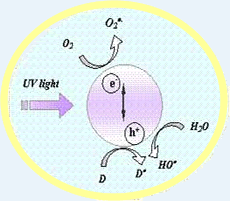What is
Nano Photo-Catalytic Filter?
The action of this filter is based on photo-catalytic oxidation
(PCO) technique. Airborne pollutants are treated by
semiconductor photo-catalysis, in which the key material is
TiO2.
TiO2 particles are used as photo-catalyst because it is
non-toxic, chemically stable, and possesses relatively high
photo-catalytic activity. Laboratory studies have demonstrated
TiO2 as the most efficient photo-catalyst for organic oxidative
degradation due to its unique features:
-
Deep and thorough
action under low temperature
At room temperature, TiO2 is active enough to completely
oxidize organic contaminants in water, air and soil into
harmless carbon dioxide, water, and simple mineral acids.
This is different from the traditional catalyzed oxidation,
which requires a temperature of at least hundreds of degrees
Celsius.
-
Effective for a wide
spectrum of organic contaminants
TiO2 has been proved to be effective for all kinds of
organic compounds varying from hydrocarbon to carboxylic
acid. All of the 114 kinds of pollutants published by the US
Environmental Protection Agency can be treated by TiO2.
Atomic organic compounds, such as dyes, nitrides and organic
pesticides are also within the capability of TiO2.
-
Strong oxidation
ability
Even organic compounds which are hardly oxidized by ozone,
such as trifluoro methane, carbon tetrachloride and
hexachlorobenzene can also be dealt with by PCO. This is
possible, because the oxidation ability of TiO2 is far
stronger than that of ozone, hypochlorous acid, potassium
permanganate. This feature is especially useful for the
degradation of obstinate organics.
-
Permanent function
TiO2 is not consumed in PCO reactions since it can deoxidize
itself under UV irradiation and resumes its high oxidation
efficiency. It can be used permanently without need of
refilling. UVA and UVC are usually required as activating
light source for TiO2.
Mechanism of TiO2
photo-catalytic degradation process

Under UV illumination, the
TiO2 photo-catalyst absorbs photons with energy equal or higher
than its band gap energy (<385nm, usually UVA and UVC are
applied). This will delocalizes a valence electron and excites
it to the conduction band of the semiconductor. These photo
excited charge carriers can initiate the degradation of the
adsorbed chemical species by one or more forms of electron
transfer reactions.
Our Air Purifier
Electron 180A applies this technology to treat different
type of contaminants such as Volatile Organic Compounds (VOCs),
germs, bacteria, microbes and viruses, and other pathogenic
microorganisms latent in home. Further more, what we adopt is
the nano-sized TiO2 technique, which allows enlarging the
surface area available for adsorption and decomposition of the
organic pollutants and thus enhancing the purification
efficiency of the filter.
How
does the UV irradiation work?
Ultraviolet Germicidal
Irradiation, specifically in the UVC wavelength, has been proven
safe and effective for almost 100 years in applications of
killing harmful microorganisms through a process called
photochemistry, which is the chemical reaction or change in
material caused by exposure to light energy. In the
photochemistry, photons in the ultraviolet spectral range are
used to excite or cleave chemical bonds of the irradiated
microorganisms and lead to the desired photo induced reaction
and thus achieve sterilization and disinfection. Many common
organic compounds based on the carbon and hydrogen combination,
or hydrocarbons, toxic compounds generally formed by
hydrocarbons associated with the lipid group as well as carbon
based biological contaminants like bacteria, viruses and fungi
all can be destructed by ultraviolet germicidal irradiation.
Almost all indoor contaminants are this type of organic
compounds.
UV light becomes particularly useful in the destruction of
contaminating organic compounds, but only when sufficient photon
energy is present. The fundamental physical requirement for the
UV light source is sufficiently high photon energy (proper
wavelength) at the required intensity. Wavelength of 254nm is
the recognized standard for optimum UV germicidal killing power.
The radiation emitted by this wavelength of UV light is very
high and any microorganism that comes in contact with it will be
destroyed almost instantaneously. The radiation emitted by the
UV lamps of Electron 180A is approximately of this wavelength.